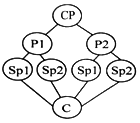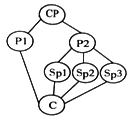-
The organic food has gained a lot of [popularity as they are being considered as healthier and tastier. A fair number of people advocate a large-scale shift to organic farming from conventional agriculture. But this might not seem well-founded.
Since the mid-19th century, conventional industrial agriculture has become incredibly efficient on a simple land to food basis. Conventional farming gets more and more crop per square foot of land, which can mean less wilderness needs to be transformed to farmland.
To make farming more efficient, conventional agriculture uses a significant amount of synthetic fertilizer(合成肥料)each year, and all that nitrogen(氮)enables much faster plant growth. However, the cost is paid in vast polluted dead zones at the months of many of the world’s rivers, because much of the nitrogen ends up running off the soil and into the oceans. This also makes conventional farming one of the major threats to the environment.
To weaken the environmental impact of agriculture, improve soil quality as well as produce healthier foods, some farmers have turned to organic farming. Environmentalists have also welcomed organic food as better for the planet than the food produced by agricultural corporations. Organic practices --- refusing artificial fertilizers and chemical pesticides –are considered far more sustainable. Sales of organic food rose 7.7% in 2010, up to $26.7 billion—and people are making those purchases for their moral senses as much as their tongues.
Yet a new meta-analysis in Nature does the math and comes to a hard conclusion: organic farming produces 25% fewer crops on average than conventional agriculture.
In the Nature analysis, scientists performed an analysis of 66 studies comparing conventional and organic methods across 34 different crop species, from fruits to grains. They found that organic farming delivered a lower output for every crop type, though the difference varied widely. For crops like fruit trees, organic trailed(落后于)conventional agriculture by just 5%. Yet for major grain crops and vegetables – all of which provide the world’s main calories – conventional agriculture outperformed organics by more than 25%.
What that means is that while organic farming may be more sustainable than conventional agriculture, there are trade-offs(此消彼长)with each. So an ideal global agriculture system may borrow the best from both systems rather than upholding merely organic or conventional practices.
1.What’s the author’s purpose of writing the passage?
A. To compare two types of farming.
B. To criticize conventional agriculture.
C. To discuss the development of farming.
D. To argue for a realistic agriculture system.
2.What do we know about conventional farming?
A. It produces more crops with fewer fertilizers.
B. It achieves efficiency at a huge cost to the environment.
C. If offers a long-term solution to global demand for food.
D. It performs far better for each crop type than organic farming.
3.What does the author most probably agree with?
A. Employing organic farming to plant rice.
B. Adopting organic practices to grow potato.
C. Using conventional methods to plant cabbage.
D. Applying conventional farming to growing apple.
4.Which of the following shows the development of ideas in this passage?
CP: Central Point P: Point Sp: Sub-point(次要点) C: Conclusion
A.  B.
B. 
C.  D.
D. 
-
The second season of The Voice of China has gained widespread popularity, as news reports _________ it.
A. put B. say C. make D. carry
-
Although modem organic food has become very popular, many people can' t figure out the difference between organic foods and ______ grown foods.
A.contemporarily B.conventionally C.deliberately D.dynamically
-
A lot of food as well as some tents _________to Yushu since the earthquake occurred.
A. has been transported B. have been transported
C. is being transported D. are transported
-
Scientists have learned a lot about the kinds of food people need. They say that there are several kinds of food that people should eat every day. They are: (1) green and yellow vegetables of all kinds. (2) citrus(柑桔) fruits and tomatoes; (3) potatoes and other fruits and vegetables; (4) meat of all kinds, fish and eggs; (5) milk and foods made from milk; (6) bread or cereal(谷类), rice is also in this kind of food; (7) butter, or something like butter.
Paragraph 2
People in different countries and different places of the world eat different kinds of things. Foods are cooked and eaten in many different kinds of ways. People in different countries eat at different times of the day. In some places people eat once or twice a day; in other countries people eat three or four times a day. Scientists say that none of the differences is really important. It doesn’t matter whether foods are eaten raw(生的) or cooked, canned or frozen. It doesn’t matter if a person eats dinner at 4 o’clock in the afternoon or at eleven o’clock at night. The important thing is what you eat every day.
Paragraph 3
There are two problems, then, in feeding the large number of people on earth. The first is to find some ways to feed the world’s population so that no one is hungry.
The second is to make sure that people everywhere have the right kinds of food to make them grow to be strong and healthy.
1.According to the scientists, which of the following groups of food is the healthiest for your lunch?
A. chicken, apples, cereal, cabbages
B. potatoes, carrots, rice, bread
C. oranges, bananas, fish, tomatoes
D. beef, pork, fish, milk
2.It is important for people to eat _______.
A. three times a day
B. dinner at twelve o’clock
C. cooked food all the day
D. something from each of the seven kinds of food every day
3.People in different countries and different places of the world _______.
A. has the right kinds of food to eat
B. cooks their food in the same way
C. has their meals at the same time
D. eat food in different ways
4.If there is Paragraph 4, what do you think is going to be talked about?
A. When people eat their lunch
B. What to do with the two problems
C. How to cook food in different ways
D. Why people eat different kinds of food
-
Nowadays with the increasing popularity of cars, people are taking ______ exercise a day as they did in the past.
A.half as much B.as half as
C.less than half much D.as half
-
There has been a lot of such news lately. As far as the problems with today's schools are concerned, we can go back to how our culture has evolved.
In general, our culture, as represented in the media, gets excited by famous stars, and stresses that it's what you have, not what you are, that counts. Parents are encouraged to be away from even very small children for most of the day. Too many people vote for politicians who would rather cut school funding than stop tax cuts for the wealthy. All contribute greatly to the problems of educating our children.
Today's teachers have to deal with a culture that is vastly different than in the past. They report that there is, among more children than ever, a lack of motivation, no drive to succeed or even try. In the media, the role models that boys see mostly consist of men in comedies and other shows, who are rude and often extremely childish; self-centered overpaid athletes; men in movies, television or video games, who are violent and powerful. As Leonard Sax wrote in Boys Adrift, "Teenage boys are looking for models of mature adulthood, but we no longer make any collective effort to provide such models."
Girls are attacked not only with such annoying images of males, but also with women who are extremely materialistic.
In such a cultural environment, it is more important than ever to have responsible parents who are devoted to their children and see to it as their duty to model for them and raise them with high standards of honesty and responsibility. They need to care enough to see that their children are not attacked with the rubbish that comes from movie, television and computer screens.
In today's culture, they are basically alone in this effort since, unfortunately, so much is working against them. Until we, as a culture, face the truth about ourselves- that we are not providing adequately for a great many of our children, as Jim Taylor titled his book "Your Children are Under Attack”。
1.What does "such news" in the beginning most probably involve?
A.Cultural evolution. B.Financial risk from tax cuts.
C.Problems in education. D.Social influence of the media.
2.What does today's culture bring to the children?
A.Narrow access to entertainment. B.Poor social abilities.
C.Few materialistic models. D.Too much negative effect.
3.What do parents have to do in today's culture?
A.Find more models for their children.
B.Keep their kids from the bad effect of the media.
C.Forbid their children to use computers.
D.Encourage their children to stay at school.
4.What is the author's attitude towards today's culture?
A.Indifferent. B.Ambiguous.
C.Dissatisfied. D.Approving.
-
Bees and butterflies are active during the daytime. They get a lot of attention for their roles as pollinators(传粉者).But moths(蛾)aren't given the prominence they deserve.
Actually, moths are seen much less often, because they're active at night. Moth bodies often seem furry. Pollen—a yellow powder in the center of most flowers, from one flower sticks to their bodies and falls off when they move to other flowers. Scientists studied insects around nine ponds on farmlands in the United Kingdom. They visited these ponds once a month from March to October.
They studied three groups of insects: moths, bees that normally work together, like honey bees, and flying insects which work alone, such as butterflies. At the ponds, the scientists caught these flying insects and died to collect pollen from their bodies. In all, the scientists checked 838 moths, 632 other insects which work alone, and 1,548 honey bees.
By studying the pollen they collected, the scientists were able to see which plants the insects had visited. The moths had pollen from 47 different kinds of plants, including seven plants that bees don't normally visit. The honey bees had pollen from 46 different kinds of plants. The other insects that work alone had visited 45 different kinds of plants. Richard Walton, who led the study, says that bees usually choose the plants with the most nectar(花蜜)and most pollen. However, moths pollinate many different plants, filling in the gaps left by the daytime pollinators.
Not only do moths pollinate plants, they also provide important food for birds and bats.
But, like many other insects, moth numbers have dropped greatly in the last 50 years, mainly because of pesticides and the loss of natural lands. Just like bees and butterflies, moths are worth protecting. "Moths are by no means less important," says Dr. Walton.
1.What does the underlined word probably mean in paragraphl?
A.Praise. B.Chances.
C.Concerns. D.Future.
2.What is the second paragraph mainly about?
A.Moths and other insects' living habits.
B.Research on insects' spreading pollen.
C.Classification of insects by scientists.
D.The ways in which moths carry pollen.
3.Compared with bees, which best describes moths?
A.They are less choosy. B.They eat less in the daytime.
C.They are more diverse. D.They carry more pollen.
4.What is the best title for the text?
A.Moths Pollinate Plants Strangely
B.Moths Are More Vital Than We Think
C.Moths Help Bees to Pollinate Plants
D.Moths Visit Some Flowers Bees Skip
-
四、Multiple choice(单项选择)15分
It looks as if they are going to _________ us a lot of money for the concert hall.
A.demand B.cost C.charge D.ask
-
It seems as if they are going to ____ us a lot of money for the party hall.
A.cost B.ask C.demand D.charge
 B.
B. 
 D.
D. 